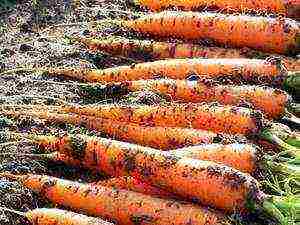Content [show]
Blue hydrangea is a flowering garden shrub. It looks great in landscape compositions, it is suitable for decorating hedges, decorating gazebos, paths. Currently, many varieties have been bred that easily endure winter and delight with their flowering for many years. There is no separate type of “blue hydrangea”. The plant got this name for the shade of its flowers. Large-leaved varieties of hydrangea are covered with blue and blue inflorescences, mainly. There are two- and three-color species that change their shade throughout the season. Today we will talk about planting and leaving blue hydrangea.
Hydrangea varieties with blue inflorescences
As a rule, these are large-leaved hydrangeas. They differ in rounded inflorescences, long and abundant flowering. Initially, flower growers saw large-leaved hydrangeas in potted versions. Such crops were not suitable for outdoor cultivation. They just froze. And only much later frost-resistant varieties were bred. Which ones have blue flowers?
Fresh articles about garden and vegetable garden
- Hydrangea "Mini Penny". Repaired grade. Blooms on the shoots of the current year. It has lush green foliage and pale blue flowers, collected in globular inflorescences.
- "Ramars". A small compact bush. Refers to multi-colored varieties. Some species are covered with purple or violet flowers. Others are spectacular bright blue and white.
- Freedom. Bicolor variety. At the beginning of flowering, pink flowers appear against a background of rich greenery. Then their middle turns blue, and the edges turn white.
- "Compeito". Hybrid variety with large purple-blue flowers, the center of which is white.
- "Performance". The pink-like flowers are pink at first. Then the hue changes to blue.
- Hopcorn Blue. A low bush up to sixty to eighty centimeters with tulip-like blue flowers. Blooms on the shoots of the second year.
- Jomari. A compact bush with blue double flowers. It also blooms on the branches of the second year.
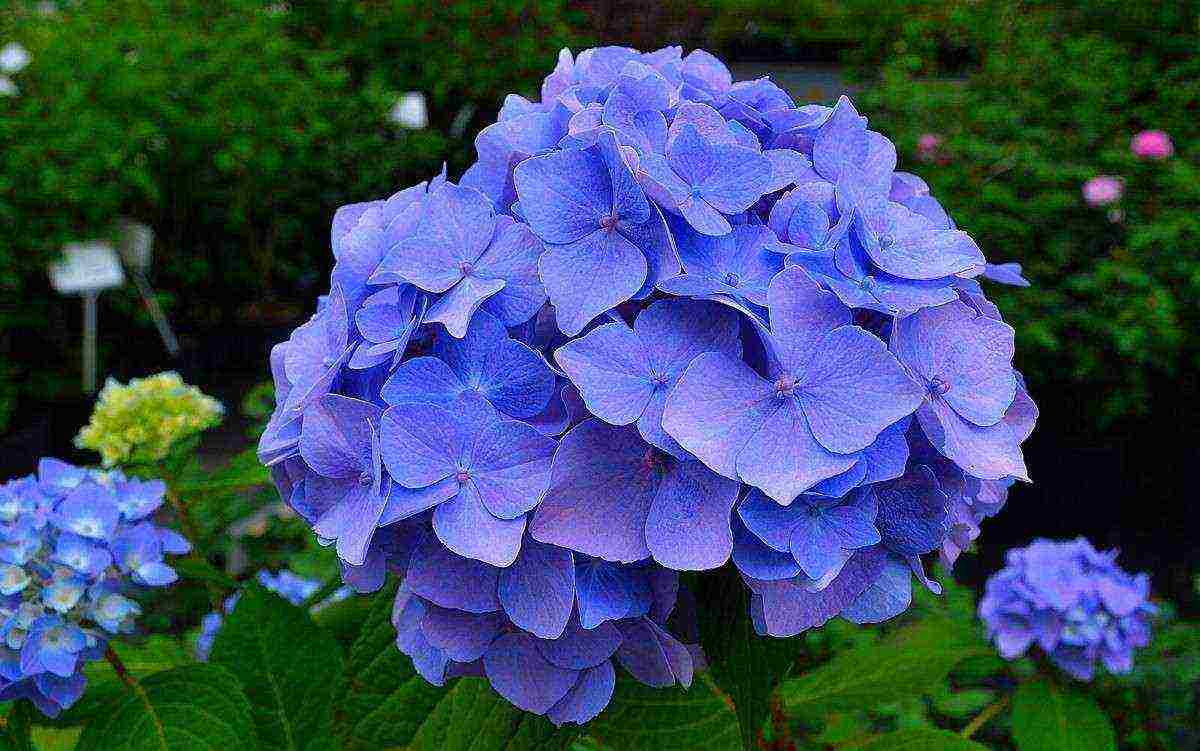
When to plant blue hydrangea
The best time to plant hydrangeas is spring, the moment when the earth thaws, the buds have not yet blossomed, and autumn is in the month of September. When choosing a place for an ornamental deciduous plant, keep in mind that it is better to plant a hydrangea in the shade or partial shade, since the bright sun causes slower growth, as a result of which the inflorescences become smaller.
Preparing the soil for planting blue hydrangea
The soil for hydrangea should be well-drained and moistened, consisting of a balanced mixture of humus, leafy soil, peat chips, river sand (2: 2: 1: 1). Regardless of the type and variety of hydrangea, remember that lime in the soil has a negative effect on development.The soil should have a Ph level of about 5.0. Alkaline soil leads to chlorosis (yellowing of the leaves). When the bush grows on alkaline soil, there is often a lack of iron and magnesium, which is manifested by light and pale color of the leaves. Therefore, acidify the soil or treat the bush with iron chelate. In past centuries, gardeners buried iron items (nails, a bank, a horseshoe). When planting, prepare a special balanced soil mixture with fertilizers.
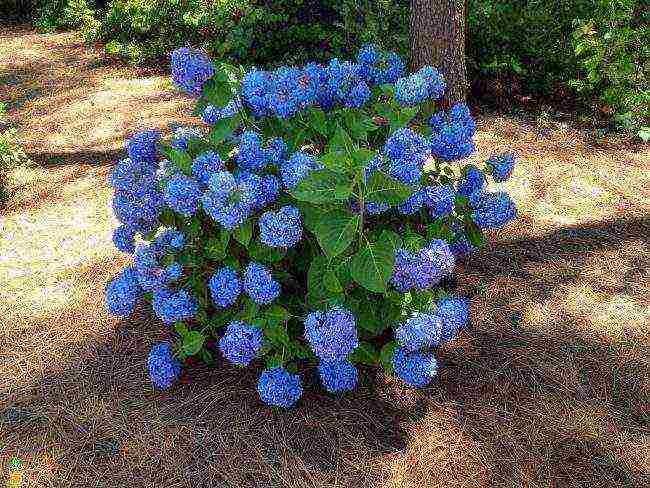
Planting blue hydrangeas outdoors
An empty planting hole must be thoroughly shed with water. The surrounding soil must be saturated with moisture. To do this, at least 3 buckets of water are poured into the pit. After a day, you can start planting the plant. For planting, mix the amount of soil substrate required to fill the pit. Dry mineral fertilizers (50 g of fertilizers per plant) are added to the specified soil composition and mixed thoroughly. You can also use specialized fertilizer for hydrangeas. The planting hole is filled with a prepared soil substrate, slightly compacting it. In the center, a hole is made the size of an earthen lump on the roots of the seedling. The bush is set in a hole, the roots are buried in earth. The earth around the bush is compacted with hands. If, after compaction, the planting pit turns out to be insufficiently filled, a substrate is added from above. After planting, the blue hydrangea is well watered so that the entire volume of soil in the pit is saturated with moisture. Following this, the soil is covered with a layer of mulch. It contains crushed bark or sawdust of deciduous trees. Soil mulching is necessary to retain moisture in the soil.
We recommend reading our other articles
When planting several hydrangea bushes, the distance between them should be at least 1 m. This is necessary so that the bushes, growing, do not shade each other. If you want to plant a hydrangea in a row, then you can dig a trench 90-110 cm wide.If you want to achieve an earlier flowering, then when planting, dig holes closer to each other (70-80 cm), and after 2-3 years thin out the bushes at necessity. Planting pit Depth - 36-45, width - 51-65 cm. The roots grow mainly in breadth, extending much further than the crown. Planting depth The root collar should be at the level of the soil, a maximum of 2-3 cm lower, otherwise the flower will not develop well. Now that you know how to plant a hydrangea correctly, you need to take care of the plant in a timely manner.
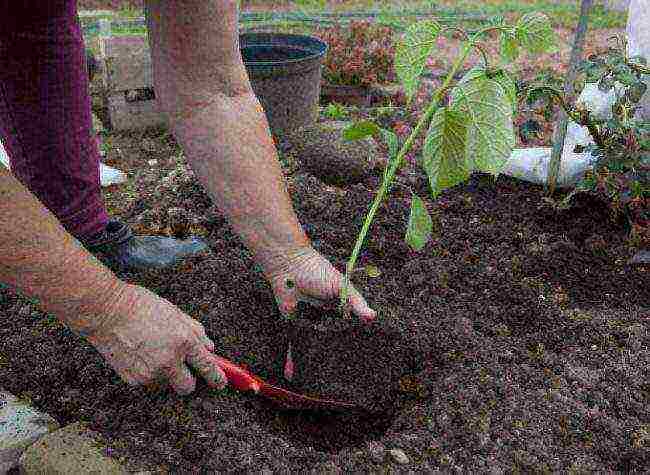
Blue hydrangea care
Hydrangea care consists in weeding and loosening the soil around it, organizing a timely and correct watering regime. In addition, to prevent rapid evaporation of moisture, it is recommended to mulch the bush in early summer with peat or sawdust.
In autumn, plants are fed with complex fertilizers, and in spring with urea (2 tablespoons per adult bush, diluted in 2 buckets of water and water). This allows them to develop and form large panicles.
During the growing season, the plant can be fertilized with slurry, but if you overdo it with organic fertilizing, then the branches of the bush can break off under the weight of the inflorescences.
Pruning blue hydrangea
It is important to form the shrub correctly. Gardeners do not like to prune branches, but in the case of panicle hydrangea without strong pruning, you can not wait for abundant flowering.
Pruning rules:
- All inflorescences are cut off in autumn.
- In the spring, all weak and frozen branches growing inside the bush are cut out on the ring.
- In the spring, the one-year growth is shortened, leaving no more than five pairs of buds on each.
Such pruning contributes to the fact that every year the bush will bloom more luxuriantly. What does "profuse flowering" mean in the case of panicle hydrangea? A five-year-old specimen, with good care, will delight the owner with several dozen panicles, and a twelve-year-old specimen with several hundred! The plant lives in the garden for 50 years or more. A specimen over 20 years old can be rejuvenated by cutting the bush into a stump.But even such pruning will not prevent the plant from blooming in the same year.
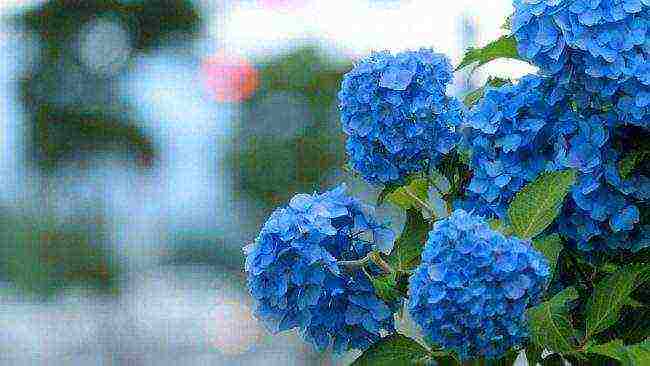
Protecting blue hydrangea from pests
Blue hydrangea is only affected by aphids and red spider mites. These pests feed on plant sap and are capable of multiplying in large numbers. Very often, the lack of control of them leads to the death of the plant.
- Leaf aphids accumulate on the tops of the shoots and petioles of the youngest leaves. Gradually multiplying, it sucks out the sap of the plant, which leads to twisting and drying of the tops of the shoots. Only purchased insecticidal preparations for the destruction of aphids can help in the fight against them.
- Spider mites are harmful arachnids. Ticks are very small and often invisible to the naked eye. You can only see cobwebs on the youngest leaves of the plant. To combat this dangerous pest, there are drugs - acaricides and insecto-acaricides that destroy harmful arachnids.
Sowing calendars for 2017
Dormant period of blue hydrangea
Novice growers may be alarmed when they notice that the leaves of the hydrangea are falling. If it happened in winter, then there is no reason to worry. The flower has begun a dormant period that lasts about 3 months. Of course, it is difficult to recognize a flowering beauty in the bare branches, but if you wait for summer, you can be sure that this is the same beautiful blue hydrangea. How to care for a wintering flower? The process is very simple. Watering is significantly reduced, however, the earthen coma must not be allowed to dry. Fertilizing is not needed. Until March, the hydrangea is harvested in a cool, dark place. Young plants, whose shoots are not lignified, do not shed their leaves and hibernate without entering a state of dormancy.
How to grow a blue hydrangea
Hydrangea attracts many gardeners, both experienced and beginner. The plant is prized for its decorative appearance, unusual leaf shape and lush flowering. It owes its name to the French princess Hortense. Later, scientists called it hydrangea, which translates as "a vessel with water." This emphasizes that the plant needs a lot of moisture. However, the scientific name did not take root among flower growers. Until now, preference is given to the original version.
Varieties
Hydrangea is most often grown in gardens, but it is possible to keep the flower at home. In total, there are about 80 varieties of this plant. There is also a division by type:
- paniculate;
- anabel;
- large-leaved;
- petiolate;
- tree-like;
- pink.
Indoors, it is recommended to keep a large-leaved hydrangea. This is due to the fact that it is less resistant to frost and does not tolerate temperature changes well. Various types of flower are common in East Asia, South and North America, Sakhalin, Kuril Islands, Japan. China is considered the birthplace of large-leaved hydrangea. In warm subtropical climates, the plant can grow up to 4 meters in height. In colder climates, it can only grow up to a meter. In nature, hydrangea flowers are pink. Today, breeders have developed new varieties with white inflorescences. But the most unusual is the large-leaved blue hydrangea.
Temperature and location
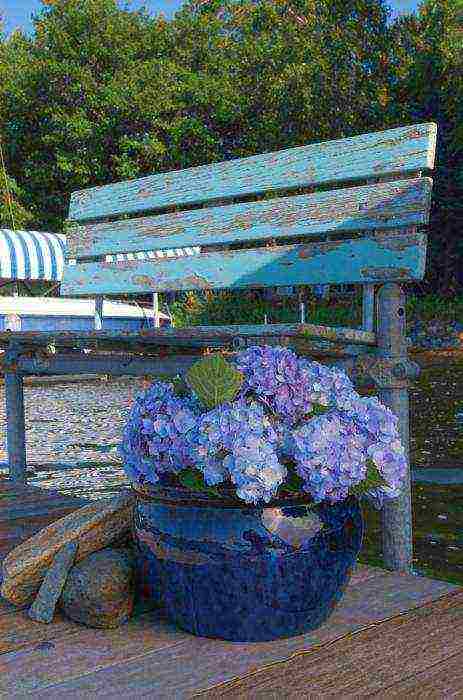
Often from novice florists, you can hear that the plant is difficult to maintain. This opinion arises from those people who do not know how to care for blue hydrangea. You should always remember that the flower belongs to the thermophilic. In summer, he needs a temperature of 18-20 degrees. If the room is warmer, the plant will begin to shed its leaves. The flower loves fresh air, so in summer it is advisable to take it out to the balcony. However, drafts and cold air currents should be avoided. In winter, the optimum temperature is 4-8 degrees.
Lighting
In the summer, during flowering and active growth, the hydrangea should be placed in partial shade or in a place where the light is diffused.It is best for the flower when the top is lit and the stem and leaves are in low shade. Blue hydrangea does not tolerate directed sunlight well, but very dark places are also not suitable for it. The flowering period begins later, and few inflorescences appear on the plant. In addition, the lack of light causes the blue hydrangea to become weak. The flower should not be allowed to touch the glass. This will cause burns on the leaves.
Humidity. Watering
From spring to late autumn, blue hydrangea requires abundant watering. However, it's important not to overdo it. Watering is done as the topsoil dries up. The water should be soft. The plant needs to be sprayed periodically. In winter, the frequency of watering is reduced to 1 time in 1.5 months. Blue hydrangea is able to withstand a slight dryness, but the earthen coma must not be allowed to completely dry out.
The soil
For planting a plant, you can take a ready-made substrate. If the necessary soil was not found in the store, then you can prepare it yourself. To do this, take 3 parts of turf, 3 parts of leafy soil and 1 part of sand. Hydrangea loves acidic soil. The pH should be between 4-5.5. The more acidic the soil is, the darker the color of the flower becomes.
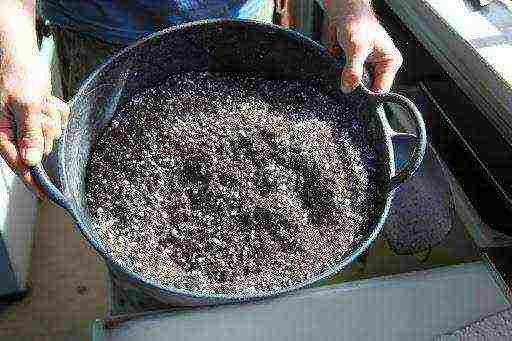
Top dressing
During flowering and active growth, indoor blue hydrangea requires additional nutrition. For this, a complex mineral fertilizer is used for plants that prefer acidic soils. Feeding is carried out once a week. 2 g of fertilizer is enough per liter of water. It is worth noting that a large amount of it is poorly tolerated by any plant, including blue hydrangea.
Planting and leaving. Reproduction. Transfer
There are several types of hydrangea breeding. The simplest and most effective indoor flower is cuttings. To do this, you need to take the lower young shoots 7-8 cm long. They should have 3-4 pairs of leaves. You need to cut the cuttings evenly, not at an angle, at a distance of 3-4 cm from the first node. The lower leaves are removed. Planting is carried out in deep containers filled with a mixture of peat and sand, to a depth of 1.5-2 cm. You can cover the cuttings with a glass cap, but it is better not to do this, as they can rot.
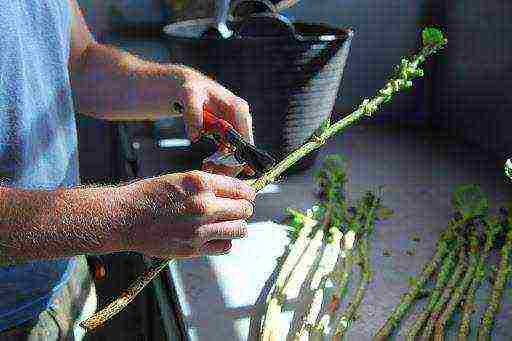
3-6 weeks are enough for the blue hydrangea to take root. Careful care of a young plant is needed. In the first seven days, it is sprayed up to 4 times a day, then reduced to 1-2 times. After rooting, the plants are transplanted into pots with prepared soil. To make the bush more lush, you need to pinch it in May. The hydrangea will bloom next year.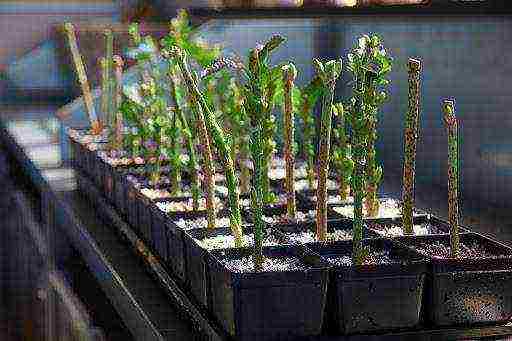
If the hydrangea bush has grown large, then it is better to plant it. To do this, the plant is divided in half so that both parts have both the top and the root. Hydrangea bushes are planted in a flower pot and fed with fertilizers. Additionally, the root cut is treated with phytohormones.
Pruning
It is carried out in the spring before the beginning of the growing season. The essence of the procedure is to remove weak and strongly elongated shoots and old inflorescences. As a result, the plant will bloom better. In addition, new strong shoots will appear. But don't be zealous. Heavily pruned hydrangea does not bloom well. On the shoots, it is necessary to leave from 2 to 6 pairs of healthy buds. After pruning, the hydrangea does not need to be fed. If the hydrangea grows too densely, then some of the shoots can be removed by cutting them at the root.
Dormant period
Novice growers may be alarmed when they notice that the leaves of the hydrangea are falling. If it happened in winter, then there is no reason to worry. The flower has begun a dormant period that lasts about 3 months. Of course, it is difficult to recognize a flowering beauty in the bare branches, but if you wait for summer, you can be sure that this is the same beautiful blue hydrangea. How to care for a wintering flower? The process is very simple. Watering is significantly reduced, however, the earthen coma must not be allowed to dry. Fertilizing is not needed.Until March, the hydrangea is harvested in a cool, dark place. Young plants, whose shoots are not lignified, do not shed their leaves and hibernate without entering a state of dormancy.
Diseases and pests. Ways to fight
Among the pests stand out:
- Aphid. To get rid of the pest, you need to treat the plant with soapy water. In case of severe damage, you will have to use organophosphate insecticidal and acaricidal preparations of a wide spectrum of action.
- Spider mite. Spraying will help to combat it. Use warm water. If you cannot achieve a positive effect, then you can use the drugs used to eliminate aphids.
Hydrangea is susceptible to the following diseases:
- Stem nematode. The leaves, stem and inflorescences are exposed to the disease, as a result of which the plant loses its attractiveness. It is impossible to save the affected flower. It will have to be destroyed to avoid spreading the disease to other plants.
- Downy mildew. It appears on leaves and stems as oily spots. Over time, they turn yellow and grow. A yellowish bloom appears on the back of the affected leaf. Due to the high humidity and temperature of 18-20 degrees, blue hydrangea is affected by powdery mildew. Care and treatment of the plant consists in treating the affected areas of the plant with copper-soapy water. In 10 liters of water, you need to dilute copper sulfate (15 g) and green soap (150 g).
- Chlorosis. Hydrangea affected by this disease has light leaves with dark veins. Chlorosis is caused by a large amount of lime or humus in the soil. To return the plant to its previous appearance, you need to dilute potassium nitrate (40 g) in 10 liters of water and water the flower 2-3 times. After 3 days, a solution of ferrous sulfate is used in the same proportions.
- Hydrangea is very sensitive to light and watering. If the flower lacks moisture, then its leaves will begin to turn yellow and curl. Excessive watering leads to root rot. Most often this happens during the rest period, when the temperature is significantly reduced. Excessive refreshment leads to the formation of light spots on the leaves. With a deficiency, the plant grows slowly and does not bloom.
- Quite often, novice growers are faced with the fact that the leaves of the hydrangea wither. There are several reasons for this problem. First you need to find out if the flower is getting enough moisture. The plant may be in direct sunlight. Leaves can wither from lack of nutrition, namely from a lack of nitrogen fertilizers. If the location is chosen correctly, watering is sufficient and there is regular feeding, then the hydrangea is sick with chlorosis.
The flower can be grown not only on the windowsill, but also outside, of course, if the climate permits. Hortense will not leave anyone indifferent, thanks to its unusual appearance. It is not the most difficult plant to care for. If desired, even a beginner can cope with it, and beautiful flowers will be a reward for caring.

Blue hydrangea can also be used in design. Its decorative appearance will easily decorate any room. The flower is perfect for decorating a theme party or wedding. If you need to create an atmosphere of tenderness and romance, hydrangea will perfectly cope with this task.
Blue hydrangea is a flowering garden shrub. It looks great in landscape compositions, it is suitable for decorating hedges, decorating gazebos, paths. Currently, many varieties have been bred that easily endure winter and delight with their flowering for many years.
There is no separate type of “blue hydrangea”. The plant got this name for the shade of its flowers. Large-leaved varieties of hydrangea are covered with blue and blue inflorescences, mainly. There are two- and three-color species that change their shade throughout the season.
In addition, the large-leaved hydrangea is easy to "recolor". You just need to create the appropriate conditions. What varieties have blue inflorescences? How to choose planting material? How to grow a hydrangea? You will find the answers to the questions in the article.
Varieties with blue inflorescences
As a rule, these are large-leaved hydrangeas. They differ in rounded inflorescences, long and abundant flowering.
Initially, Russian flower growers saw large-leaved hydrangeas in potted versions. Such crops were not suitable for outdoor cultivation. They just froze. And only much later frost-resistant varieties were bred. Which ones have blue flowers?
- Hydrangea "Mini Penny".
Repaired grade. Blooms on the shoots of the current year. It has lush green foliage and pale blue flowers, collected in globular inflorescences.
- Ramars.
Small compact bush. Refers to multi-colored varieties. Some species are covered with purple or violet flowers. Others are spectacular bright blue and white.
- Freedom.
Bicolor variety. At the beginning of flowering, pink flowers appear against a background of rich greenery. Then their middle turns blue, and the edges turn white.
- "Compeito".
Hybrid variety with large purple-blue flowers, the center of which is white.
- "Performance".
The pink-like flowers are pink at first. Then the hue changes to blue.
- Hopcorn Blue.
A short bush up to sixty to eighty centimeters with tulip-like blue flowers. Blooms on the shoots of the second year.
- Jomari.
Compact bush with blue double flowers. It also blooms on the branches of the second year.
These are the most popular varieties. Many of them change color during one flowering period. Pink hydrangea can be purchased, planting and care provided in accordance with the requirements. And then the flowers turn blue. This is the peculiarity of the variety. We just didn't pay attention to it.
The hydrangea color changes easily. During the budding period, the bush must be watered with aluminum alum (for two liters of water - a teaspoon with a slide). Then the white color will turn blue, pink - lilac, purple or blue-blue.
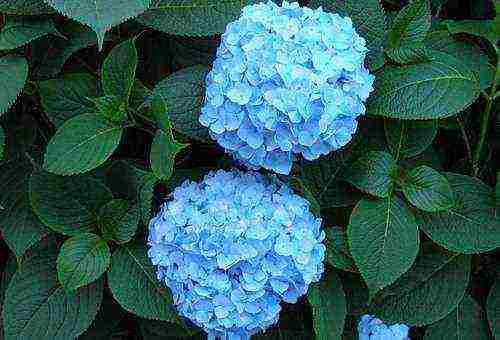
How to plant
For planting, seedlings of three-, four-year-old shrubs are ideal. It is better to buy them in specialized real or online stores. The root system of the seedlings must be protected and hidden in some material. In the store, containers are used for these purposes. Growing up consists of:
A place.
-
Hydrangeas love partial shade. Open sunny spaces do not like moisture-loving shrubs. In the shade, hydrangea blooms poorly, blooms later. This plant needs a middle ground.
-
When planning group plantings, it is necessary to take into account that the shrub requires space for growth and development. The optimal free diameter around each hydrangea is two meters.
The soil.
Beautifully flowering shrubs love acidic, moisture-consuming and loose soils. Such conditions can be provided in the following ways:
- bring soil from the forest (you need to dig the ground under the pine trees together with needles);
- mix equal amounts of high-moor peat, leaf and turf soil, sawdust compost, sand.
Hydrangeas don't like lime in the soil!
Landing.
Dig a hole the night before (width, length and height - half a meter). Pour in five buckets of water. The next day, add the prepared substrate, place the seedling, gently spread the roots and cover them with earth. Water well and cover with pine needles or peat.
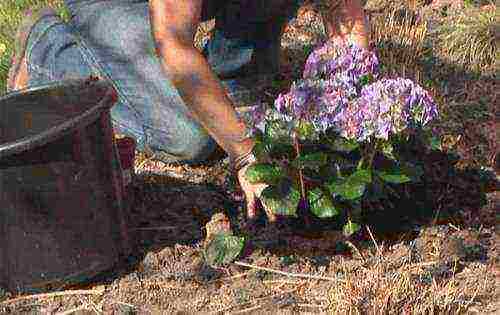
Care
Decorativeness, color saturation, elasticity of leaves and shoots depend on proper watering, pruning, dressing.
Watering.
Hydrangea loves water. With a lack of moisture, it withers, blooms poorly. If you give several buckets of water under such a plant, it immediately comes to life.
The optimal frequency of watering is once or twice a week. For each bush, you need to give three to four buckets.If, after watering, you mulch the soil around the hydrangeas, then water it once every ten days. The mulch will retain moisture for longer.
Conclusion: in no case should the soil around the hydrangeas be allowed to dry out.
Fertilization.
Large-leaved blue hydrangea loves feeding and responds very well to them. Fertilizers need to be applied depending on the period of plant development:
- at the end of spring - the first feeding of superphosphate, potassium sulphide and urea (2: 2: 1.5);
- in the middle of summer (during the formation of inflorescences) - the second feeding of superphosphate and potassium sulphide (2: 1);
- in late summer - early autumn (during the period of active flowering) - the third top dressing, organic (compost or rotted manure).
To protect the hydrangea from disease, it is recommended to periodically add any fungicide to the irrigation water (especially in the first year after planting).
Conclusion: hydrangeas need mineral fertilizers; during the period of active flowering - organic. Under no circumstances should ash be brought in!
Pruning.
This is a mandatory step in caring for shrubs. Regardless of the variety. Treelike, Grandiflora, Paniculata, Japanese, Phantom hydrangea ... Planting and leaving will not be complete without pruning.
Almost all varieties of large-leaved blue hydrangea bloom on last year's shoots. This must be taken into account when pruning. It is important to keep the flower buds at the ends of the branches.
Do not touch the inflorescences in the fall. They will protect flower buds from winter frost. They can be removed in the spring:
- in April, completely cut off a quarter of old shoots that are more than three years old;
- the rest have only last year's inflorescences;
- remove weak, diseased and overly exposed branches.
Conclusion: it is impossible to shred a large-leaved hydrangea, since inflorescences appear only on last year's branches.
Wintering of blue hydrangea.
-
Water the plant actively from late summer. It should meet the winter strong enough. To prevent the shoots from stifling under cover, treat the bush with Bordeaux mixture.
-
At the end of October, when light frosts are observed at night, the hydrangea can be covered with perforated polyethylene or agrospan. In early November, tilt the shoots to the ground, cover with spruce branches or dry leaves. And put the box on top.
Conclusion: blue varieties of hydrangeas are prepared for winter, like roses (they reliably protect from frost).
All types of hydrangeas - petiolate, paniculate, tree-like, oak-leaved and large-leaved - amaze the imagination with their exquisite beauty. With their help, you can successfully transform both small private farms and large farmlands. By planting a hydrangea around the perimeter of the site, between trees, near a shop or a house, you will create a piece of paradise that will catch your eye.
Of all the listed species, only oak-leaved and large-leaved hydrangeas do not tolerate cold climates. The latter is generally quite capricious, so its cultivation requires considerable effort. However, this frightens few people, because the result fully justifies all the efforts expended. So, today we will discuss the main rules by which it is grown large-leaved hydrangea - planting and care in the open field.
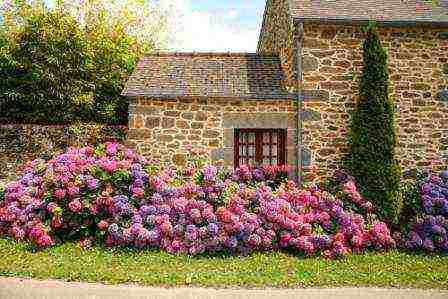
Brief description of large-leaved hydrangea
Large-leaved hydrangea is a shrub up to 2 meters high with smooth shoots. The leaves are ovoid and bright green in color, the diameter of each spherical inflorescence is 15 cm. You can see several variants of hydrangea bushes grown in the open field in the attached photos. Note that pink flowers indicate that the shrub grows in alkaline soil, while blue or blue flowers indicate the presence of acids in the soil.
In order to plan the continuous "elegance" of your site, it is important to take into account that the large-leaved hydrangea begins to bloom in June and stops in September or October. This perennial plant does not tolerate cold winters even under special shelter.In view of this, shrubs are planted only in the southern regions, perhaps with moving indoors for the winter. The difficulty lies in maintaining the viability of flower buds, which are located on the tops of last year's shoots.

See also: Venus flytrap: home care
How to plant hydrangeas outdoors?
Where to plant large-leaved hydrangea? This ornamental plant does not like the burning sun, so it should be planted in partial shade. For example, a garden with tall trees or a place near any buildings (not on the south side) would be a great place for him. In short, choose a place where the direct rays of the sun will fall no more than 6 hours a day. In addition, hydrangea does not like winds.
How to find the right neighbors? Hydrangea is moisture-loving, so it should not be planted next to the same moisture-loving shrubs or trees. She also does not tolerate when her root system is damaged, therefore it is not recommended to plant annuals requiring transplantation nearby.
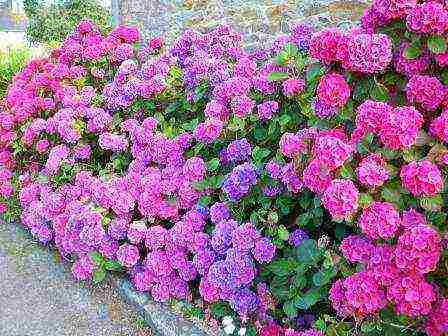 Planting large-leaved hydrangea should be carried out in an area with partial shade
Planting large-leaved hydrangea should be carried out in an area with partial shade
When to plant hydrangea outdoors? Planting will be equally successful in spring and early autumn.
How to plant a large-leaved hydrangea? To do this, you need a pit 50 cm deep and with the same diameter. To fill it, a mixture of peat, soil, needles and humus should be prepared. If the soil is heavy, a drainage layer must be placed on the bottom. The roots are soaked in water before planting. When planting, the root collar is not deeply buried, since young growth will appear from it. After sprinkling the roots, the seedling is abundantly watered and mulched with peat, needles or sawdust.
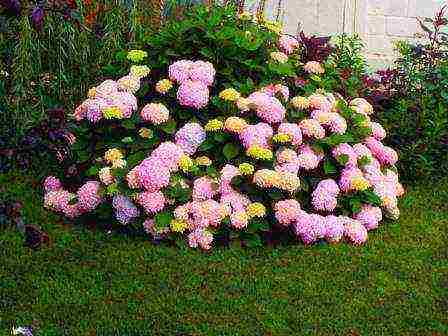
How to care for large-leaved hydrangea?
Watering
"A vessel with water" - this is how the name of this shrub is translated from the ancient Greek. It is not hard to guess that the plant loves water. It is important that the ground underneath never dries out. A layer of mulch is of great help in this. Large-leaved hydrangea needs especially abundant watering before winter.
Top dressing
This is an indispensable part of caring for a shrub, which will help it show its splendor to the fullest. It is better not to risk it, but to feed the hydrangea with the help of a complex fertilizer specially designed for it. Alternatively, you can use liquid manure or humus, but in this case it is important not to overdo it. In no case do not use ash for feeding large-leaved hydrangea outdoors, as it does not like alkaline soil. When is it worth feeding? In spring before blooming and in autumn shortly before the end of flowering of the bush.
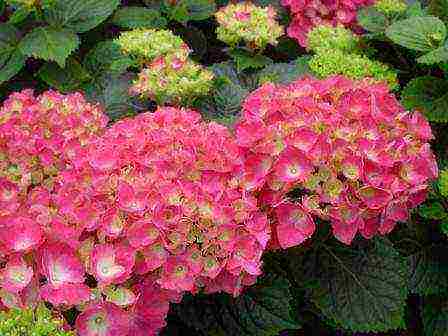
Hydrangea care should include regular watering and feeding
Pruning
Like all shrubs, the large-leaved hydrangea needs pruning, however, without observing the subtleties of this process, you can get a bush with practically no flowers. So, in the first year, all weak shoots are removed. In the spring, 1-2 buds are cut off on the growths, and in the fall, the growths and branches growing inside the bush are removed. In subsequent years, pruning is done after flowering, cutting off all branches that have faded to the lower strong growths. All weak branches are removed completely. If the bush is too thick, it should be thinned out.
Preparing for winter
Even in the southern regions, the hydrangea needs to be covered for the winter, otherwise it will at least not bloom. The lower part of the bush is sprinkled with peat, and then, bending down the branches, the plant is covered with sawdust, leaves and covered with spruce branches. From above we cover the planting with agrofibre and slate or roofing material.
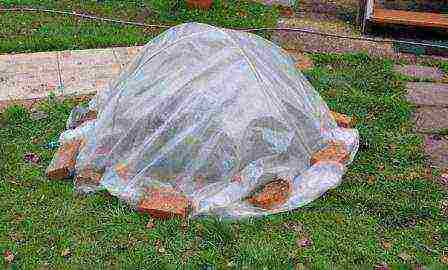
Reproduction
The most reliable way to propagate hydrangea outdoors is by dividing the bush. Separating the parts, it is important that each of them has growth buds, and we cut off the shoots, leaving 3-5 buds. Another breeding method (simpler) is by layering. A hole 15 cm deep is dug near the bush and the bent shoot of the bush is fixed in it with a wire bracket.At the point of contact with the ground, you need to remove the bark from the branch, and cut off the leaves. We place the top of such a shoot vertically, tying it to a peg. By the fall, the cuttings should take root, and next spring it can be transplanted.
If you live in a region with moderately cold winters, a large-leaved hydrangea must appear on your site. Planting and grooming outdoors is tricky, but the result will delight you and your neighbors for months. Not so long ago, the hydrangea was exclusively a house plant, but now it has got out on freedom. Don't miss the chance to create an enchanting corner in your outdoor area with this beauty.
Watch the video: Large-leaved hydrangea: care, shelter for the winter
